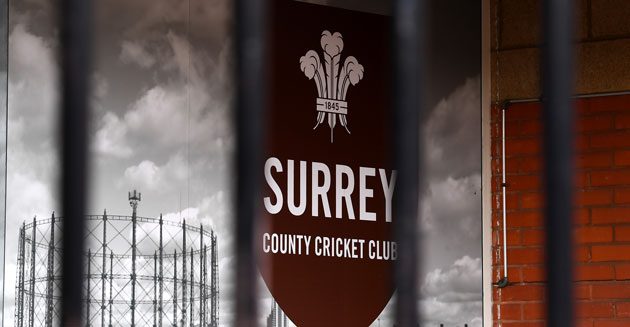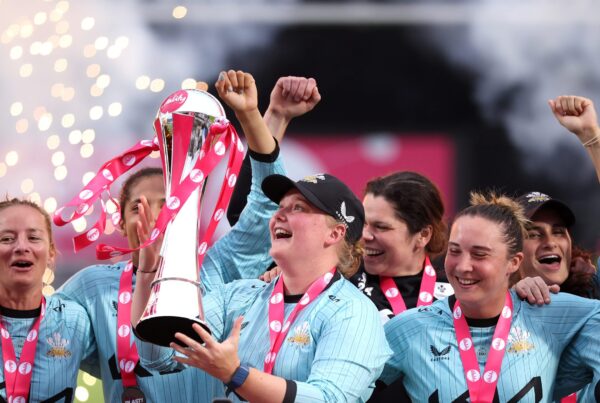Three of cricket’s greats – Sonny Ramadhin, Rodney Marsh and Shane Warne – died this week. All relished their visits to The Oval.
Richard Spiller looks back.
Sonny Ramadhin
Chilly post-war Britain can hardly have felt like the ideal place for Sonny Ramadhin to make his first trip out of Trinidad. The first East Indian to play for West Indies, both he and left-arm spinner Alf Valentine were daring choices for the 1950 tour, given their youth and lack of experience.
Yet they were to prove central to John Goddard’s side winning not only their first Test here – a series-levelling triumph by 326 runs at Lord’s, having lost heavily in the opener at Old Trafford – but going on to claim the Trent Bridge Test by 10 wickets.
Could they wrap it up at The Oval? Ramadhin had sat out West Indies’ first outing against Surrey in May and when they returned for a second encounter in early August, he was missing for the opening two days for what Wisden described as a “chill”. Not that his colleagues appeared to be missing him much, dismissing the hosts for 161 and replying with a mighty 434 all out.
It was in the second innings that Surrey finally had a chance to pit their wits against the mystery spinner, who could make the ball turn either way with no discernible change of action. Laurie Fishlock led the resistance by making 97, Ramadhin dismissing Bernie Constable, Jack Parker and Alec Bedser in his 3-59 while Valentine swept away much of the rest – including Fishlock – in claiming 5-60 to ensure victory by an innings and 69 runs.
They were back 10 days later and the result was just as emphatic against an England side showing eight changes. By making 503, through centuries by Allan Rae and Frank Worrell, the tourists set the perfect platform for their spinners. England’s reply of 344 owed almost everything to Len Hutton’s unbeaten 202 but it still could not save them from following on. Valentine and Goddard had claimed four wickets each, Ramadhin confined to one victim.
Spin’s supremacy was underlined by Goddard opening with his slow men second time round, this time Ramadhin claiming 3-38 – including Surrey wicketkeeper Arthur McIntyre on his Test debut – in taking his tally for the series to 26 although again it was Valentine who claimed the honours by finishing with 6-39, routing England for 103. Ramadhin’s fellow Trinidadian Lord Beginner could celebrate the success of “those two little pals of mine” in a Calypso which wonderfully evokes the era.
He didn’t have much to sing about when West Indies returned seven years later.
Ramadhin’s potency seemed as great as ever in his devastating 7-49 in the first innings of the opening Test at Edgbaston but in the second skipper Peter May (285no) and Colin Cowdrey (154) produced one of cricket’s epic partnerships, adding 411, although their use of the pads to kick away deliveries remains controversial.
West Indies took on Surrey at The Oval soon after, Ramadhin unfit to bowl in the second innings after claiming two wickets in the first and Surrey great Micky Stewart taking advantage by stroking 147 in a match the hosts almost won. When West Indies returned, now 2-1 down in the series, it was to claim a morale-boosting success against Surrey by seven wickets, Ramadhin finishing with five wickets in the match, although little good it did them.
The Oval Test in mid-August was among the most one-sided in the history of the game. Without the injured Valentine at the other end, Ramadhin’s 4-107 from 37.5 overs included top-scorer Tom Graveney for 164, England finishing with 412. Yet the tourists crumbled miserably, dismissed twice by just after lunch on day three for 89 and 86, Surrey and England’s own spinners Tony Lock and Jim Laker utterly dominant.
Rod Marsh
Like Ramadhin, Rodney Marsh’s early experiences of The Oval were probably his happiest, his career extending to five Ashes tours and two World Cups in England.
His first trip, in 1972, saw Marsh make an unbeaten 58 in Australia’s first innings of their tour match, which took him past 2,000 first-class runs. Nicknamed “Iron Gloves” after his unimpressive debut series down under in 1970-71, Marsh cut a slighter but more impressive figure 18 months later but Ian Chappell’s side had seen their ambition to recapture the Ashes evaporate by the time they returned to The Oval for the final Test in mid-August.
Feeling they had been ambushed on a pitch perfect for left-arm spinner Derek Underwood at Headingley, Marsh admitted: “We were not happy campers.”
A Test which was stretched to six days gave them the ideal chance to earn some compensation by levelling the series, Marsh being bowled for a fourth-ball duck by Underwood in the first innings.
But in the second, chasing 242, he came together with Paul Sheahan (44no) at 171-5 on the sixth afternoon and the pair took advantage of the absences of injured bowlers John Snow and Ray Illingworth as they guided the Australians to a fine victory. When victory came, Marsh (43no) rushed over waving his bat around in celebration to celebrate a well-deserved share of the series.
It was after that match that Marsh introduced what has become a dressing room tradition for Australian Test players, singing “Under the Southern Cross I Stand” following victories, although he adapted the words to a version you wouldn’t hear on Songs of Praise.
The left-hander’s aggressive batting rescued his side on many occasions or flayed tiring attacks. Three years later, in the inaugural World Cup, Marsh walked in at 61-5 against West Indies in the final group qualifier, both sides already assured of a place in the last four, and cracked 52no in a partnership worth 99 with Ross Edwards.
But the bullets of Dennis Lillee and Jeff Thomson which had so terrorised England the previous winter made less impact on West Indies as Alvin Kallicharran’s 78 guaranteed West Indies victory by seven wickets with 14 overs to spare.
In the four-Test series which followed, Ian Chappell’s side retained the Ashes won back the previous winter, England’s hopes of levelling the series sabotaged when vandals dug up the pitch at Headingley as they bid to make it 1-1.
An extra day was added again, Chappell’s 192 driving his side to 532-9 and Marsh’s brisk 32 adding more foot soreness for the home attack. But then he had to keep from late on the second day until after tea on the sixth, England compensating for their meagre 191 by following on with 538 all out as they took advantage of a mordant pitch. It said much for Marsh’s concentration, and evidence that the “Iron Gloves” sobriquet was way out of date, that just two runs came in byes over that marathon.
Back just two years later for a full Ashes series, Australia were a lesser force without Lillee and Ian Chappell, Marsh becoming vice-captain to Greg Chappell. Unsettled by many of them having signed for Kerry Packer’s World Series Cricket, the tourists were hammered 3-0 to lose the Ashes again, both visits to The Oval badly affected by rain in a generally miserable summer.
Only one day was possible in their tour match against Surrey in early May, Marsh taking three catches as the home side made 327-8 before the weather closed in.
It was little better when the fifth Test came round, washing out the opening day but after England had been dismissed for 214, Australia’s reply of 385 included a remarkably restrained 57 in 151 balls from Marsh.
Once the Packer schism was repaired, the players involved having been excluded by Australia in the previous year’s World Cup, Australia were back for a short tour in 1980 which included the Centenary Test.
It included a three-day clash with Surrey at The Oval, where Marsh’s solid batting form continued by hitting 56 in the second innings, although he could not avert a defeat by 59 runs for the tourists. And his 41 in a one-day international soon after was also in a losing cause, becoming one of five victims for Mike Hendrick in a 23-run setback.
One of Marsh’s greatest regrets was that he was never made Australian captain, again finding himself as second lieutenant to Kim Hughes for the full Ashes tour a year later.
There was no tour match at The Oval but the ground made history by hosting the first sixth Test of an Ashes series in this country.
Coming after the remarkable feats of Ian Botham and Bob Willis in a Mike Brearley-inspired revival, it would have taken much to outshine the miracles of Headingley, Edgbaston and Old Trafford. Marsh more than played his part as a shoal of records were achieved, his knocks of 12 and 52 seeing him past 3,000 Test runs and his departure in the second innings – skying a catch to midwicket – handing Botham his 200th wicket at that level. Marsh and Lillee had the last word with Brearley, combining to remove him for 51 in the second innings, but the wicketkeeper’s long-running adversary in the England side, Alan Knott, ensured the match was saved.
Shane Warne
If the passing of Ramadhin, aged 92, and Marsh – who had suffered a serious heart attack last week at the age of 74 – seemed sadly inevitable, then the death of Warne at just 52 came as a terrible shock in a time when events around the world might have made us immune to that emotion.
His 708 Test wickets underlined a claim to be the greatest spinner in the history of cricket, his partnership with fast bowler Glenn McGrath the backbone of an Australian side which would dominate the world game for a generation. In the process Warne reignited the art of leg-spin, even if he made the job of those wishing to emulate him nigh on impossible.
Warne’s 32 Test wickets at 22 in four matches make him the highest wicket-taker at The Oval among overseas players, five in front of Michael Holding.
His first Ashes tour, in 1993, had started with a sensation at Old Trafford when he bowled Mike Gatting with what was named as the “ball of the century”. Allan Border’s men were 4-0 up when they arrived at The Oval for the sixth Test and although Warne claimed five wickets, Mike Atherton’s much-changed side claimed a morale-boosting 161-run victory.
Under Mark Taylor, they had also retained the Ashes four years later, this time Warne finishing with four wickets as the hosts squeezed home by 19 runs.
One of the most remarkable aspects of Warne’s career was the way he came back from major surgery on both his right shoulder and spinning finger, adjusting his game and possessing the nous and experience to compensate for not being able to rip the ball so sharply.
Under Steve Waugh in 2001, Australia reached The Oval 3-1 up and amassed 641-4dec before facing their examination by Warne. Needing three wickets to reach 400, he achieved it by dismissing Alec Stewart for the landmark wicket among an extraordinary 7-165 from 44.2 overs, only held off by Mark Ramprakash’s 133, another 4-64 in the follow on seeing the tourists to victory by an innings and 25 runs.
Australian supremacy had been halted – at least temporarily – by 2005 but Warne wasn’t going to let England retake the Ashes without a fight. Michael Vaughan’s team were 2-1 up but had to battle all the way to 373 all out against Warne’s 6-122. And after they had taken a six-run lead, he squeezed them tightly with another 6-124 in the second innings, although his dropped catch at slip which let off centurion Kevin Pietersen overshadowed that performance.
When Pietersen finally departed after securing the urn for England, Warne ran over to offer his congratulations.
And a final memory is when he played for Hampshire at Whitgift School, being confronted by a long line of autograph hunters. Warne pulled up a chair and made sure every single child went home satisfied.
That’s the action of a true legend.
Click here for a more detailed look at Shane Warne’s Oval career












